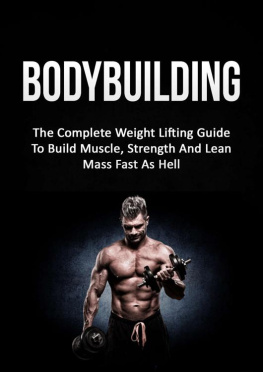In its simplest terms, strength training is a type of physical training that entails using resistance to induce muscular contractions that ultimately build the size, anaerobic endurance, and strength of different skeletal muscles and brings about improved bone density.
This involves engaging in any exercise that drives your muscles out of their comfort zone. This, in turn, forces them to rebuild and become stronger in anticipation of the next challenge.
This involves utilizing more effort than the previous work out (e.g., lifting a heavier weight or including an extra rep) consistently. This forces your muscles to adapt relentlessly, which essentially means they will continuously be rebuilding to become stronger.
This means that if you move away from this guide and do ten squats and ten push-ups, you have done a type of strength training known as bodyweight training. It is that simple!
But for the sake of specificity, lets go in-depth where we focus on the science and specifics of strength training.
Strength Training And Your Muscles: The Science Behind It
Our bodies have 642 muscles. All these muscles function together to help our bodies stand, move and exist. They work in pure harmony. For instance, when you bend your arm, the triceps elongate, and the biceps do the opposite (contract) so that your elbow can bend.
When these muscles get out of their comfort zone (by use of body weight or when you pick up weight), this is where strength training comes in. Pushing the muscles leads to muscle break down, and they tear slightly, where, over the next 24 to 48 hours, they rebuild and become stronger and tougher. These microscopic muscle tears are the basis of strength training, and it is known as hypertrophy.
This comes in 3 forms:
- Transient hypertrophy
This is simply a temporary increase in muscle size that occurs as you train and right after, caused by the accumulation of fluid in the intercellular space- commonly known as the pump.
- Myofibril hypertrophy
This focuses on toughening the myofibril (the contractile part of your muscles) to help you build strong muscles.
- Sarcoplasmic hypertrophy
This concentrates on increasing the level of sarcoplasm (a non-contractile fluid in the muscle). It helps build your overall size.
However, these muscle tears come with the challenge of muscle soreness, as your body changes and rebuilds. Imagine this - these tears form in the connective tissue and fiber of muscles, so pain is inevitable. But with enough rest and proper diet, full repair occurs within a couple of days.
Strength Training And Weight Loss
How does strength training help with weight loss? Is it even possible to lose weight through strength training? And if so, how does it happen?
Well, strength training helps you build muscle, and muscle has more capacity to burn more calories than fat (3 times more). And it doesnt end once you finish your workout. Your body keeps burning calories for the next 24 to 48 hours, as it maneuvers to repair your stressed muscle tissue. This is known as the after-burn effect or EPOC (excess post-exercise oxygen consumption). The more oxygen you use as you work out and even after, the more the EPOC.
Other than that, strength training revs up calorie burn during the workout, let alone through the building of muscle.
We all have muscles right now, regardless of the amount of body fat you have. The muscle is just hiding behind layers of fat.
You should know that fat and muscle are two different things and one cannot transform into the other. For you to burn fat, lose weight and look lean, you need to build your muscles to make them tighter and stronger and to burn the fat on top of your muscles.
A great way to do both of these things simultaneously is through strength training. So you will lose weight as you strength train and keep the muscle you have - you dont have to lose weight first before you strength train.
So what sort of body changes should you expect from your strength training efforts?
Lets discuss that next.
Strength Training And Body Changes
As the body rebuilds its muscles (because of strength training), the muscle also increases in strength and capacity. Usually, the old tissue is usually discarded before the synthesis of new tissue. Consuming a lot of protein will help to provide raw material to help with the synthesis of new muscle (we will learn more about strength training and diet later on in the book).
Keep in mind that it will take a bit of time to start seeing body changes. However, this does not mean that the changes are not ongoing. They are happening; you dont see them until the changes are substantial enough for you to notice them.
This is especially if you have a lot of body fat because your body will constantly be burning fat and building new muscles, which can give you the idea that you still look the same. Trust me; you will start seeing a leaner you sooner than later.
If you are above 30 years old, it is possible to start losing up to 3-8% of your lean muscle mass per decade. So if you are above this age and begin strength training, seeing body changes becomes more effortless. This is because if you have already lost some muscle mass, you generate new muscle where there wasnt any. Consistently strength training will enable you to hang on to lean muscle for much longer and maintain that lean frame. It is possible to be more advanced in age and lean at the same time.









